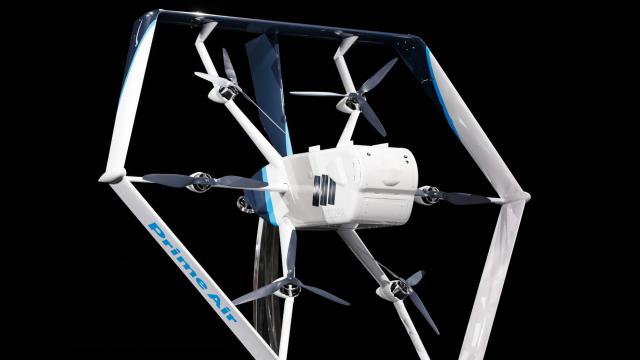The U.S. Federal Aviation Administration has given the go-ahead for Amazon’s fleet of Prime Air drones. Yes, that means Amazon can now begin trialing air deliveries in the U.S. With drones. Commence weeping, for the commerce dystopia is one step closer to coming true.
That said, just because Amazon got approval from the FAA, it doesn’t mean that tomorrow an Amazon drone will drop off a can of Fido’s dog food into your front yard. It means that Amazon has obtained a Part 135 Air Carrier Certificate, which according to the FAA’s website is currently “the only path for small drones to carry the property of another for compensation beyond visual line of sight.”
[referenced id=”1218191″ url=”https://gizmodo.com.au/2020/05/i-climbed-trees-for-an-hour-to-find-this-mavic-air-2-and-id-still-buy-it/” thumb=”https://gizmodo.com.au/wp-content/uploads/2020/05/26/vwziq0ckkb2odhrg6jzr-300×169.gif” title=”I Climbed Trees for an Hour to Find This Mavic Air 2, and I’d Still Buy It” excerpt=”It might have forced me to commune with nature unexpectedly, but I still want DJI’s new drone: The Mavic Air 2.”]
To get Part 135 certification, Amazon said it had to submit evidence that its drones could safely deliver packages, and then give a demonstration of its plans for the FAA. That included handing over manuals, protocols for operation, training, and maintenance. In total, Amazon says it has developed and validated over 500 safety and efficiency processes for its certification submission, and that its goal is to make deliveries in 30 minutes or less from the time a customer places an order.
“This certification is an important step forward for Prime Air and indicates the FAA’s confidence in Amazon’s operating and safety procedures for an autonomous drone delivery service that will one day deliver packages to our customers around the world,” David Carbon, Amazon’s vice president of Prime Air, said in a statement. “We will continue to develop and refine our technology to fully integrate delivery drones into the airspace, and work closely with the FAA and other regulators around the world to realise our vision of 30-minute delivery.”
Amazon declined to comment on where it’ll start testing these drones, but Bloomberg notes that it already has test sites in the Pacific Northwest and Vancouver, and has previously done trials in the UK.
None of this is new. Amazon’s been yammering about the idea of air drone deliveries for years. Hell, in 2013, it promised that this would be a reality in five years… and it’s been almost seven. Shit, it’s been so long that the drone Amazon will probably use for trials doesn’t even look anything like the drone featured in that concept video from 2013. Its latest MK27 drone is hexagonally-shaped, can supposedly carry packages under 2.2 kilograms, and flies as far as 24 km.
Besides obvious problems like getting tangled up in power lines and, you know, possibly chopping pets and people into spaghetti, there are several other problems that need to be sussed out before the sky is cluttered with buzzing delivery drones. For starters, drones will have to fly preprogrammed routes without human operators, under various weather conditions. They’ll have to do so without getting attacked by birds (imagine a bloody rain of feathers and machine bits) or crashing into other drones and other aircraft. Per Bloomberg, the FAA hasn’t even figured out standards for autonomous air deliveries, and would likely have to set regulations for things like noise levels — on top of developing a new air traffic system for drones.
Amazon isn’t the only company that’s gotten FAA clearance. Alphabet’s Wing delivers medications and food in Australia and Virginia. Meanwhile, the FAA also cleared UPS to deliver medical supplies in North Carolina (with drones, that is.) Uber also supposedly wants in on that drone delivery action.
That said, all these companies face the same hurdles as Amazon. It’ll likely be years before we realistically see drone deliveries the way any of these companies envision, but in the meantime, you should enjoy those clear, drone-free skies while you still can.
